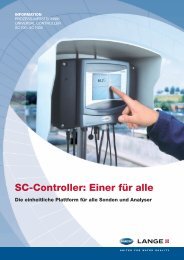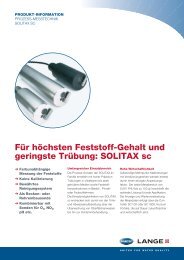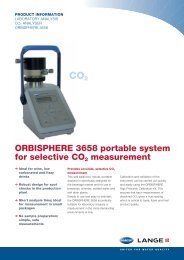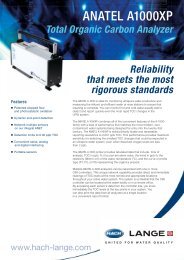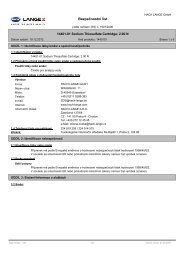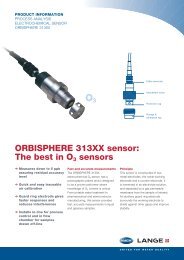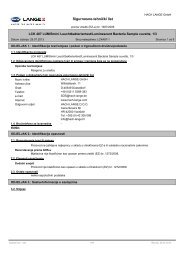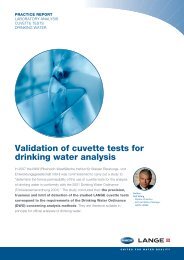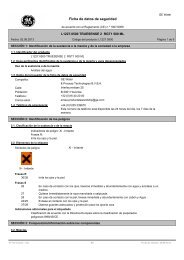Optimal nutrient ratios for wastewater treatment - HACH LANGE
Optimal nutrient ratios for wastewater treatment - HACH LANGE
Optimal nutrient ratios for wastewater treatment - HACH LANGE
Create successful ePaper yourself
Turn your PDF publications into a flip-book with our unique Google optimized e-Paper software.
6 NUTRIENTS_CONTROLRegulating the substrate dosage bymeans of NO 3 -N measurementsTable 5: Average daily values of a municipal <strong>wastewater</strong> <strong>treatment</strong> plantAverage daily valuesInflow [m 3 /d] 10,000BOD 5 infl aer [mg/L] 110TN infl aer LATON [mg/L] 45P tot infl aer [mg/L] 3,5BOD 5 infl aer. : TN infl aer = 110:45 = 2.45Table 6: Calculation of amount of nitrogen that is not to be denitrified (ΣN n.d. )N incorporated in biomass (5 % of BOD 5 infl aer)N org.e (e = assumed target quantity in the outflow)NH 4 -N e (e = target quantity in the outflow)NO 3 -N e (e = target quantity in the outflow)SumTable 7: Denitrification capacity in accordance with ATV-A131(guideline values <strong>for</strong> dry weather and temperatures from 10 to 12°C)5.5 mg/L2 mg/L0 mg/L8 mg/L15.5 mg/LV D /V ATC Deni (Denitrification capacity in kg NO 3 -N D /kg BOD 5 )Volume Deni/Volume Aeration Upstream denitrification Simultaneous and intermittentdenitrification0.2 0.11 0.060.3 0.13 0.090.4 0.14 0.120.5 0.15 0.15V D : Volume of the aeration tank used <strong>for</strong> denitrificationV AT : Volume of the aeration tank3. Calculating the externalsubstrate requirementThe still to be denitrified N content is thetotal added nitrogen minus the amountof nitrogen that is not to be denitrifiedminus the amount of nitrogen that theplant can denitrify:S NO3-N, D, Ext = TN Inflow - N n.d. - S NO3-N, D= 45 mg/L - 15.5 mg/L - 16.5 mg/L= 13 mg/LTo denitrify the remaining 13 mg/L nitrogen,the microorganisms in the acti -vated sludge must be provided withan additional source of carbon. A daily<strong>wastewater</strong> volume of 10,000 m 3 has anitrogen load of 130 kg. According toDWA Work Sheet A131, the externalcarbon requirement is 5 kg COD/1 kgNO 3 -N. This means that, <strong>for</strong> completedenitrification to occur, 650 kg COD areneeded per day. If the additional carbonis provided in the <strong>for</strong>m of acetic acid,the data provided in Table 8 indicate that607 kg would have to be added eachday. The targeted dosage is based onthe NO 3 -N values.Table 8: External carbon sources <strong>for</strong> calculating the necessary dosageAcetic acid Methanol EthanolCOD kg/kg 1.07 1.50 2.09TOC kg/kg 0.40 0.38 0.52BOD 5 kg/kg 0.70 0.96 1.35Density kg/m 3 1,060 790 780In this example, 1 kg acetic acid is equivalent to 1.07 kg COD.ConclusionsUnfavourable <strong>nutrient</strong> <strong>ratios</strong> and highconcentrations of individual substancesreduce the degradation efficiency ofbiological <strong>wastewater</strong> <strong>treatment</strong> processes.Early recognition and continuousmonitoring of critical parameters is there<strong>for</strong>eessential in order to enable plantoperators to take rapid corrective actionwhen necessary. Only in this way cancompliance with legal outflow values beensured and unnecessarily high <strong>wastewater</strong>levies be avoided. <strong>LANGE</strong> cuvettetests and continuously operating processmeasurement devices have demonstratedthat they are indispensable aidsto achieving greater transparency andreliability.www.hach-lange.com



